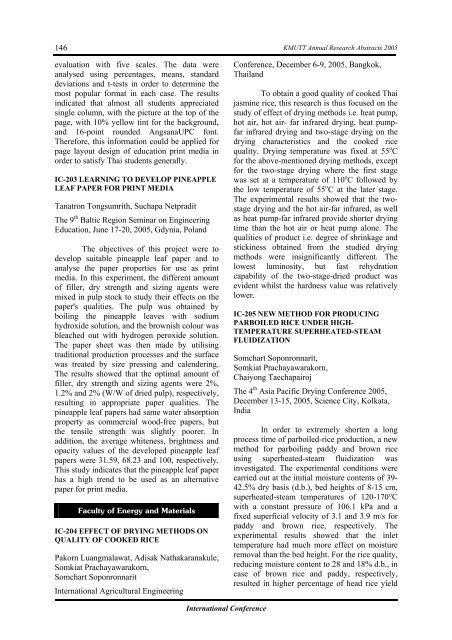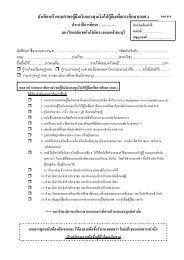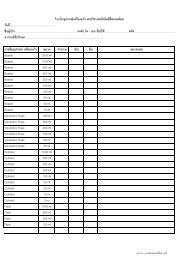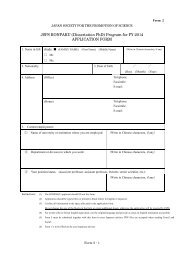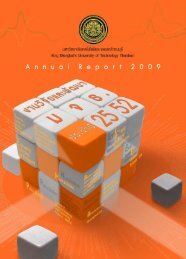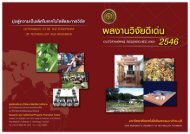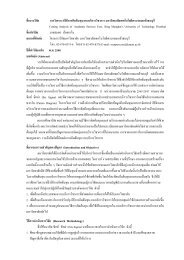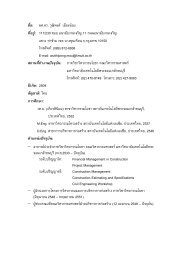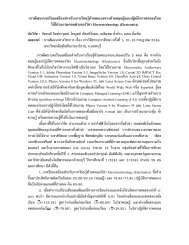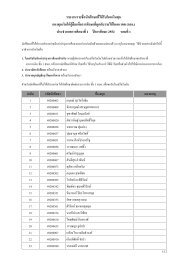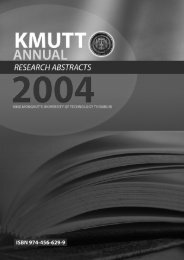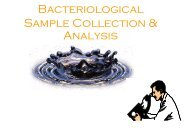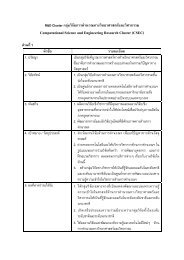You also want an ePaper? Increase the reach of your titles
YUMPU automatically turns print PDFs into web optimized ePapers that Google loves.
146<br />
evaluation with five scales. The data were<br />
analysed using percentages, means, standard<br />
deviations and t-tests in order to determine the<br />
most popular format in each case. The results<br />
indicated that almost all students appreciated<br />
single column, with the picture at the top of the<br />
page, with 10% yellow tint for the background,<br />
and 16-point rounded AngsanaUPC font.<br />
Therefore, this information could be applied for<br />
page layout design of education print media in<br />
order to satisfy Thai students generally.<br />
IC-203 LEARNING TO DEVELOP PINEAPPLE<br />
LEAF PAPER FOR PRINT MEDIA<br />
Tanatron Tongsumrith, Suchapa Netpradit<br />
The 9 th Baltic Region Seminar on Engineering<br />
Education, June 17-20, 2005, Gdynia, Poland<br />
The objectives of this project were to<br />
develop suitable pineapple leaf paper and to<br />
analyse the paper properties for use as print<br />
media. In this experiment, the different amount<br />
of filler, dry strength and sizing agents were<br />
mixed in pulp stock to study their effects on the<br />
paper's qualities. The pulp was obtained by<br />
boiling the pineapple leaves with sodium<br />
hydroxide solution, and the brownish colour was<br />
bleached out with hydrogen peroxide solution.<br />
The paper sheet was then made by utilising<br />
traditional production processes and the surface<br />
was treated by size pressing and calendering.<br />
The results showed that the optimal amount of<br />
filler, dry strength and sizing agents were 2%,<br />
1.2% and 2% (W/W of dried pulp), respectively,<br />
resulting in appropriate paper qualities. The<br />
pineapple leaf papers had same water absorption<br />
property as commercial wood-free papers, but<br />
the tensile strength was slightly poorer. In<br />
addition, the average whiteness, brightness and<br />
opacity values of the developed pineapple leaf<br />
papers were 31.59, 68.23 and 100, respectively.<br />
This study indicates that the pineapple leaf paper<br />
has a high trend to be used as an alternative<br />
paper for print media.<br />
Faculty of Energy and Materials<br />
IC-204 EFFECT OF DRYING METHODS ON<br />
QUALITY OF COOKED RICE<br />
Pakorn Luangmalawat, Adisak Nathakaranakule,<br />
Somkiat Prachayawarakorn,<br />
Somchart Soponronnarit<br />
International Agricultural Engineering<br />
KMUTT Annual Research Abstracts 2005<br />
Conference, December 6-9, 2005, Bangkok,<br />
Thailand<br />
To obtain a good quality of cooked Thai<br />
jasmine rice, this research is thus focused on the<br />
study of effect of drying methods i.e. heat pump,<br />
hot air, hot air- far infrared drying, heat pumpfar<br />
infrared drying and two-stage drying on the<br />
drying characteristics and the cooked rice<br />
quality. Drying temperature was fixed at 55 o C<br />
for the above-mentioned drying methods, except<br />
for the two-stage drying where the first stage<br />
was set at a temperature of 110 o C followed by<br />
the low temperature of 55 o C at the later stage.<br />
The experimental results showed that the twostage<br />
drying and the hot air-far infrared, as well<br />
as heat pump-far infrared provide shorter drying<br />
time than the hot air or heat pump alone. The<br />
qualities of product i.e. degree of shrinkage and<br />
stickiness obtained from the studied drying<br />
methods were insignificantly different. The<br />
lowest luminosity, but fast rehydration<br />
capability of the two-stage-dried product was<br />
evident whilst the hardness value was relatively<br />
lower.<br />
IC-205 NEW METHOD FOR PRODUCING<br />
PARBOILED RICE UNDER HIGH-<br />
TEMPERATURE SUPERHEATED-STEAM<br />
FLUIDIZATION<br />
Somchart Soponronnarit,<br />
Somkiat Prachayawarakorn,<br />
Chaiyong Taechapairoj<br />
The 4 th Asia Pacific Drying Conference 2005,<br />
December 13-15, 2005, Science City, Kolkata,<br />
India<br />
In order to extremely shorten a long<br />
process time of parboiled-rice production, a new<br />
method for parboiling paddy and brown rice<br />
using superheated-steam fluidization was<br />
investigated. The experimental conditions were<br />
carried out at the initial moisture contents of 39-<br />
42.5% dry basis (d.b.), bed heights of 8-15 cm,<br />
superheated-steam temperatures of 120-170°C<br />
with a constant pressure of 106.1 kPa and a<br />
fixed superficial velocity of 3.1 and 3.9 m/s for<br />
paddy and brown rice, respectively. The<br />
experimental results showed that the inlet<br />
temperature had much more effect on moisture<br />
removal than the bed height. For the rice quality,<br />
reducing moisture content to 28 and 18% d.b., in<br />
case of brown rice and paddy, respectively,<br />
resulted in higher percentage of head rice yield<br />
International Conference


